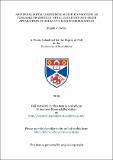Artificial metalloenzymes : modified proteins as tuneable transition metal catalysts and their application in oxidative lignin degradation
Abstract
The selective oxidation of organic molecules is fundamentally important to life and immensely
useful in industry.
Metalloenzyme catalysed oxidations often display exquisite substrate
specificity as well as regio and/or stereoselectivity. Huge strides have occurred in the field of
biocatalysis in recent years. Work has developed by taking inspiration from nature’s enzymes,
to use directed evolution and engineering methods to create tailor made catalysts. Artificial
Metalloenzymes (ArMs) provide the possibility to expand this repertoire further by combining
the advantageous features of enzymes with the versatile reaction scope of transition metals.
The initial chapter in this thesis takes a look into recent literature about artificial
metalloenzymes and their application in oxidation catalysis.
Chapter two describes the design rationale and synthesis of protein templates and synthetic
cofactors for the development of artificial metalloenzymes. Successful modification was
achieved for a wide library of nitrogen donor ligands, creating an array of artificial
metalloenzymes that can be tested in catalytic reactions. In the absence of a crystal
structure of the modified protein, UV and CD analysis were carried out to gather
characteristic information about the artificial metalloenzymes and their metal binding
properties. An investigation was also carried out to determine the most accurate method to
calculate protein concentration once it has been modified with a cofactor.
The third chapter describes the application of protein engineering to increase the
thermostability of the target protein. Variants of an artificial metalloenzyme were created by
rational design using structural and bioinformatic information. The variants were tested to
identify mutations that enhanced the stability of the protein scaffold. Significant increases in
melting temperature were observed in a number of the modified metalloenzymes. Their
ability to withstand higher reaction temperatures resulted in increased activity in the
hydroformylation of 1-octene, with >5-fold improvements in turnover numbers (TON).
The fourth chapter reports the use of artificial metalloenzymes in oxidation catalysis. In
particular their application to the degradation of lignin is investigated. Using a model
compound that mimics the most abundant linkage within lignin as a substrate, a wide array
of artificial metalloenzymes were tested to study if any oxidation or cleavage occurs.
Investigations were carried out to find the optimum conditions varying catalyst loading and
buffer/solvent composition. Complete selective conversion to ketone product is observed
using SCP-2L A100C modified with a tris(2-pyridylmethyl) amine based cofactor, coordinated
to Fe(OTf)₂.2MeCN. Engineering the protein scaffold to incorporate glutamic acid was found
to improve the ArM activity, showing that rational design of the protein environment using
metal binding amino acids can be a method to improve the overall activity of an artificial
metalloenzyme.
Type
Thesis, PhD Doctor of Philosophy
Collections
Items in the St Andrews Research Repository are protected by copyright, with all rights reserved, unless otherwise indicated.

